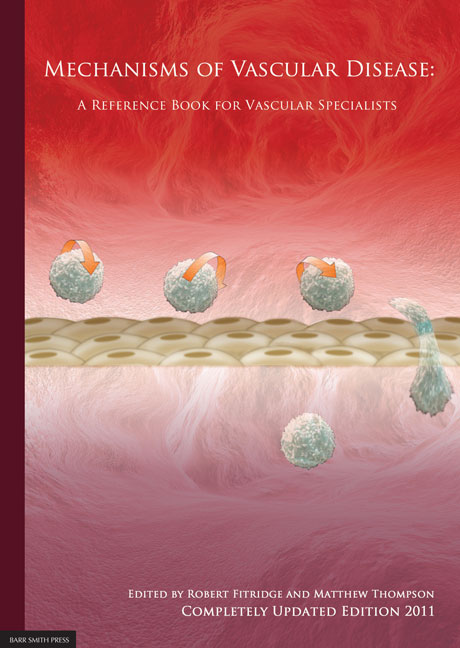Book contents
- Frontmatter
- Contents
- List of Contributors
- Detailed Contents
- Acknowledgements
- Abbreviation List
- 1 Endothelium
- 2 Vascular smooth muscle structure and function
- 3 Atherosclerosis
- 4 Mechanisms of plaque rupture
- 5 Current and emerging therapies in atheroprotection
- 6 Molecular approaches to revascularisation in peripheral vascular disease
- 7 Biology of restenosis and targets for intervention
- 8 Vascular arterial haemodynamics
- 9 Physiological Haemostasis
- 10 Hypercoagulable States
- 11 Platelets in the pathogenesis of vascular disease and their role as a therapeutic target
- 12 Pathogenesis of aortic aneurysms
- 13 Pharmacological treatment of aneurysms
- 14 Pathophysiology of Aortic dissection and connective tissue disorders
- 15 Biomarkers in vascular disease
- 16 Pathophysiology and principles of management of vasculitis and Raynaud's phenomenon
- 17 SIRS, sepsis and multiorgan failure
- 18 Pathophysiology of reperfusion injury
- 19 Compartment syndromes
- 20 Pathophysiology of pain
- 21 Post-amputation pain
- 22 Treatment of neuropathic pain
- 23 Principles of wound healing
- 24 Pathophysiology and principles of varicose veins
- 25 Chronic venous insufficiency and leg ulceration: Principles and vascular biology
- 26 Pathophysiology and principles of management of the diabetic foot
- 27 Lymphoedema – Principles, genetics and pathophysiology
- 28 Graft materials past and future
- 29 Pathophysiology of vascular graft infections
- Index
28 - Graft materials past and future
Published online by Cambridge University Press: 05 June 2012
- Frontmatter
- Contents
- List of Contributors
- Detailed Contents
- Acknowledgements
- Abbreviation List
- 1 Endothelium
- 2 Vascular smooth muscle structure and function
- 3 Atherosclerosis
- 4 Mechanisms of plaque rupture
- 5 Current and emerging therapies in atheroprotection
- 6 Molecular approaches to revascularisation in peripheral vascular disease
- 7 Biology of restenosis and targets for intervention
- 8 Vascular arterial haemodynamics
- 9 Physiological Haemostasis
- 10 Hypercoagulable States
- 11 Platelets in the pathogenesis of vascular disease and their role as a therapeutic target
- 12 Pathogenesis of aortic aneurysms
- 13 Pharmacological treatment of aneurysms
- 14 Pathophysiology of Aortic dissection and connective tissue disorders
- 15 Biomarkers in vascular disease
- 16 Pathophysiology and principles of management of vasculitis and Raynaud's phenomenon
- 17 SIRS, sepsis and multiorgan failure
- 18 Pathophysiology of reperfusion injury
- 19 Compartment syndromes
- 20 Pathophysiology of pain
- 21 Post-amputation pain
- 22 Treatment of neuropathic pain
- 23 Principles of wound healing
- 24 Pathophysiology and principles of varicose veins
- 25 Chronic venous insufficiency and leg ulceration: Principles and vascular biology
- 26 Pathophysiology and principles of management of the diabetic foot
- 27 Lymphoedema – Principles, genetics and pathophysiology
- 28 Graft materials past and future
- 29 Pathophysiology of vascular graft infections
- Index
Summary
THE PATHOPHYSIOLOGY OF GRAFT HEALING
The mechanisms of graft healing are of central importance in understanding the successes and failures of current bypass grafts. The tissue response to implantation of a prosthetic graft is complex with many variable factors involved such as the material used, its construction, its porosity, and its length. Further important factors relate to the interaction between the graft and the host artery at the anastomotic areas. Until recently graft design focused on simple conduits for blood flow which were strong (resistant to pressure), biologically inert (resistant to biodegradation) and non-leaking. Each of the major causes of graft failure, luminal thrombogenicity, compliance mismatch and anastomotic intimal hyperplasia, have the potential to be modulated if their aetiology could be better understood. A further stimulus to study of this area is the still unresolved puzzle of man's inability to endothelialise a prosthetic graft beyond the immediate 2 cm or so from the anastomosis.
The peri-anastomotic area
Intimal or neointimal hyperplasia is a characteristic healing reaction to vascular injury. In prosthetic grafting the injury typically involves the direct trauma of implantation, and subsequent exposure of the anastomotic areas to haemodynamic stress (compliance mismatch, turbulent flow and altered shear stress). This results in injury which is transmural with endothelial removal, variable disruption of the internal elastic lamina and medial smooth muscle cells (SMC).
The three phases of intimal hyperplasia will develop quite rapidly with the first being proliferation of medial smooth muscle cells as soon as 24 hours after injury and lasting up to 4 weeks.
- Type
- Chapter
- Information
- Mechanisms of Vascular DiseaseA Reference Book for Vascular Specialists, pp. 511 - 536Publisher: The University of Adelaide PressPrint publication year: 2011
- 1
- Cited by

